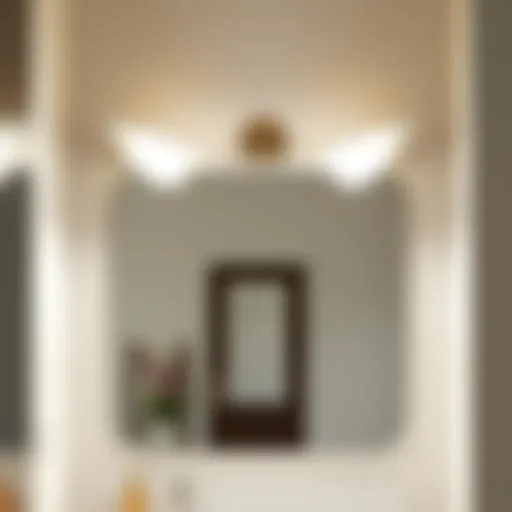The Essence of a Navajo Bath Mat: Tradition Meets Contemporary Design
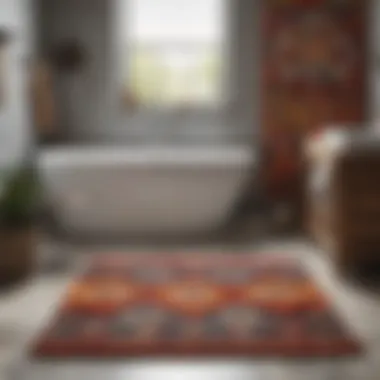
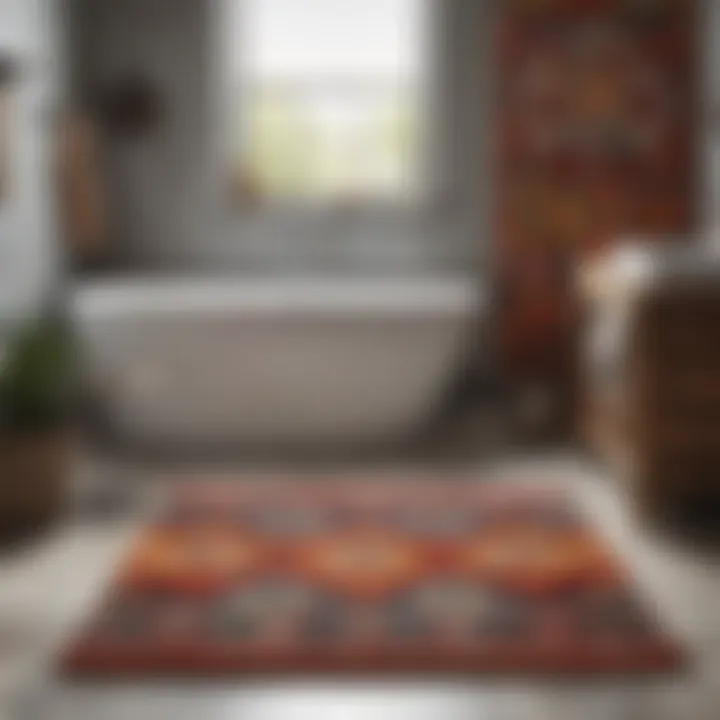
Intro
When one thinks of a bath mat, it may seem like a simple household item, but the Navajo bath mat transcends mere functionality. This textile masterpiece is a fusion of rich cultural heritage and modern aesthetics, acting not only as a practical solution for wet floors but also as a powerful statement of identity and artistry. With roots deeply embedded in Navajo traditions, these mats are vibrant canvases showcasing the skills and stories of their makers.
As we delve into the intricacies of the Navajo bath mat, we will explore its profound cultural significance, craftsmanship techniques, and how it has adapted over time to meet contemporary design sensibilities.
In this journey, we will identify current trends in the market, the diverse color palettes that define them, and the popular styles that have emerged. Moreover, we will provide insights into visual ideas, including how these mats can be integrated into various interior settings, transforming not only bathrooms but also the broader aesthetic landscape of a home. By understanding the essence of the Navajo bath mat, you will be equipped to make informed choices that celebrate this exquisite blend of tradition and modernity.
Understanding Navajo Culture
The essence of a Navajo bath mat extends beyond mere functionality; it encapsulates the rich culture of the Navajo people. To appreciate these textiles fully, one must delve into the depths of Navajo cultural heritage. This understanding not only informs our aesthetic choices but also invites a respectful engagement with the traditions behind the craft. The symbols, colors, and designs woven into the mat tell stories of history, spirituality, and identity that go far beyond the bathroom floor.
Historical Overview
Historically, the Navajo Nation has been known for its deep-rooted connection to the land and its commitment to preserving traditions. The artistry of Navajo weaving emerged from essential practices, where the loom became a miniaturized landscape reflecting their beliefs and daily lives. The skill has been passed down through generations, beginning with simple, functional textiles and evolving into intricate patterns that communicate the Navajo worldview.
To put it simply, the Navajo bath mat is not just a mat; it’s a canvas on which stories of ancestry and culture are elegantly spun. The designs may include motifs like the spider's web, symbolizing creativity, or the lightning, which signifies power and healing. These elements are carefully chosen, each thread serving a purpose far beyond its appearance. The lasting cultural significance behind these creations can transform a bathroom into more than just a personal space—it can become a sanctuary steeped in profound heritage.
Artistic Expression
Artistic expression in Navajo culture dances delicately between practicality and beauty. Each mat is a representation of not only craftsmanship but also a way of interpreting everyday life through art. The weavers incorporate various designs, which often reflect significant events, legends, and landscape features of the Navajo homeland.
Consider the following elements that characterize Navajo artistry:
- Symbolism: Many designs incorporate symbols that hold deep meanings. For instance, the use of geometric shapes can signify balance and harmony that the Navajo strive for in their lives.
- Color Use: Colors in Navajo textiles are not randomly chosen. Instead, they have meanings associated with the natural elements. For example, red can represent the earth, while blue symbolizes the sky, connecting the weaver to their environment.
- Innovative Techniques: Navajo weavers have developed distinct techniques over centuries. These methods have transformed the act of weaving from a mundane task into a form of artistic exploration.
The contemporary bath mat not only serves its practical functions but also showcases intricate artistry that invites individuals to reflect on their cultural significance. Knowing these aspects fosters a deeper connection between the consumer and the craft, encouraging a sense of appreciation that transcends the aesthetic appeal.
Ultimately, when you stroll across a Navajo bath mat, you’re stepping into a narrative where tradition meets modernity—a beautiful amalgamation of values, art, and history that resonates with many, especially those looking to enrich their living spaces with something truly special.
"Each piece tells a story that echoes across generations, reminding us that every thread woven carries with it the weight of tradition and a vision for the future."
By understanding these elements, one gains insights into how Navajo culture enriches the aesthetic and emotional landscape of our homes. Embracing this depth transforms home decor from a mere showcase of items into a tapestry of meaningful expression.
The Craftsmanship of Navajo Textiles
The craftsmanship involved in creating Navajo textiles, particularly bath mats, is not just a practical endeavor; it embodies the history, culture, and artistry of the Navajo people. Each piece is carefully crafted with techniques that have been passed down through generations, making them more than mere decorative items—they are a tapestry of rich traditions and stories.
Techniques Used in Weaving
The weaving techniques employed by Navajo artisans are a meticulous blend of skill, tradition, and artistry. For centuries, they have used the vertical loom, a tool that allows for complex patterns and textures.
The process begins with the selection of the right materials, traditionally wool, which is prized for its durability and warmth. Spinning wool into yarn requires not just physical prowess but also a deep understanding of the material properties.
Once the yarn is spun, the real artistry begins. One of the techniques prevalent in Navajo weaving is the use of natural dyes. These dyes, made from plants, minerals, and sometimes even insects, provide a rich palette of colors, often inspired by the surrounding landscape. The colors are not randomly chosen; they carry symbolic meanings, often reflecting the connections the Navajo people have with nature and the universe.
Adding texture to the mat is another important aspect. Artisans may incorporate various weaving patterns such as serrated, stepped, and geometric designs that help create a three-dimensional feel. Each knot, each pass of the shuttle, contributes to a unique story that goes beyond the visual appeal.
"Navajo weavers don’t just make textiles; they weave the very essence of their history into each creation."
This attention to detail not only showcases a commitment to craftsmanship but also preserves the cultural heritage of the Navajo community.
Materials and Sustainability
Sustainability plays a central role in the crafting of Navajo textiles. Historically, the Navajo have utilized locally sourced materials, which contributes to a more sustainable practice. The wool, for instance, often comes from flocks of sheep that are raised in the high desert, where conditions shape the quality of the fleece. In today’s context, there is a growing appreciation for the environmental impact of these materials.
The focus on natural fibers means that these mats aren’t just environmentally friendly—they are also healthier options for the home. They tend to be biodegradable ,which reduces their environmental footprint when compared to synthetic alternatives.
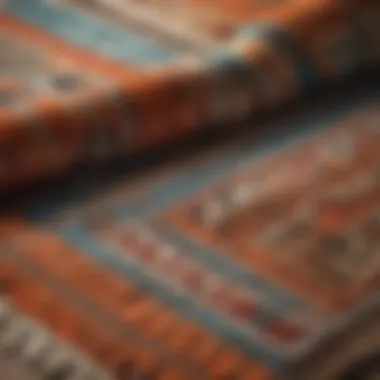
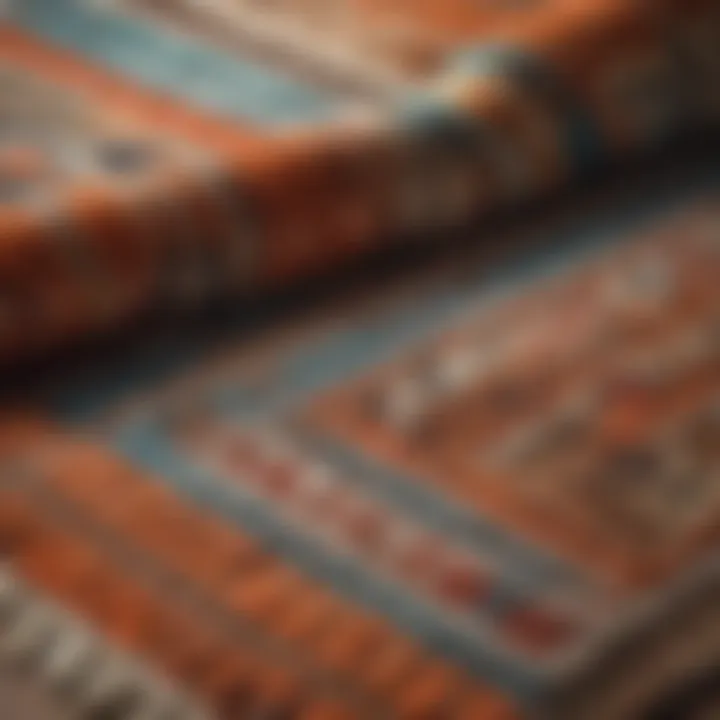
Another sustainable practice is the preservation of traditional techniques. By choosing to maintain these ancient methods, artisans are helping to ensure that future generations will learn and adopt these practices. This connection to the past enriches the present, creating a cycle of cultural appreciation.
As consumers become more conscious of their purchases, support for handmade, sustainably sourced items continues to grow. Choosing a Navajo bath mat is not just about aesthetics—it's a step toward honoring the craftsmanship behind each piece and recognizing the cultural significance woven into every strand.
Aesthetic Appeal of Navajo Bath Mats
The aesthetic appeal of a Navajo bath mat goes beyond a mere decorative flourish in a bathroom. It embodies a deep-rooted cultural essence while presenting itself as a striking element of contemporary design, acting as a bridge between the traditional and the modern. This aesthetic isn't just about looking nice; it's about telling a story and creating an atmosphere.
A Navajo bath mat can possess a multitude of patterns and colors that reflect the vibrant heritage of Navajo artistry. Here, we dive into how its stunning design can transform a mundane space into a focal point that resonates with character and warmth.
Design Motifs and Patterns
Design motifs on Navajo bath mats are not just visually pleasing; they often have profound meanings grounded in centuries of tradition. One common pattern includes geometric shapes, which symbolize various elements of nature. For instance, zigzag lines might represent lightning, while squares could signify the land or the foundations of one’s life. These motifs are chosen carefully, making each mat not merely a textile but a canvas of personal stories and historical narratives.
- Cultural Significance: The chosen designs often serve a dual purpose, beautifying spaces while imparting cultural knowledge.
- Versatility: From the intricate weavings that might catch the eye in a rustic bathroom to more toned-down designs that mesh seamlessly with minimalist decor, these mats are as adaptable as they are beautiful. The designs can range from vibrant pops of color showcasing the energy of Navajo culture to more subdued patterns for those looking to incorporate subtle elegance.
- Personal Expression: Select designs that resonate with one's personality or values. Choosing a mat based on its motif could be seen as a dialogue between the mat's history and one’s personal narrative.
Color Palettes and Their Impact
Colors play a pivotal role in design aesthetics, influencing mood and enhancing the overall environment of a space. A Navajo bath mat's color choices often draw on nature—think deep reds reminiscent of clay, soft blues representing the sky, or earthy greens echoing the land. These color palettes can evoke feelings of comfort and tranquility, creating an inviting oasis in one's home.
- Warm vs. Cool Tones: Warm colors can create an energetic and welcoming atmosphere, perfect for those seeking a lively space. On the other hand, cool tones might promote a sense of calm and relaxation, ideal for a spa-like setting.
- Complementary Choices: When selecting a Navajo bath mat, considering the current bathroom color scheme is important. A bold, colorful mat can serve as a striking contrast to neutral walls, becoming a centerpiece that draws the eye. Conversely, selecting a mat with shades that tie into existing decor can create a harmonious blend.
- Seasonal Variation: As seasons change, so can the mat—using warmer tones in cooler months, and cooler tones as the weather heats up can refresh the space and keep it feeling engaging.
The integration of Navajo motifs and colors into modern interiors is not just a trend; it’s a journey of honoring tradition while embracing contemporary aesthetics.
By understanding the aesthetic appeal of Navajo bath mats, homeowners and decorators can elevate their spaces, offering more than functionality. They promote a deeper cultural appreciation and embody the essence of personal expression through design.
The Role of Bath Mats in Interior Design
Bath mats may seem like a simple addition to any bathroom, but their role far exceeds their utilitarian purpose. In the realm of interior design, the right bath mat can tie a space together, providing an aesthetic coherence that enhances the overall experience of a bathroom. These pieces are small yet impactful, serving both functional and decorative needs. When selecting a Navajo bath mat, one must consider how it complements existing decor and contributes to the feel of the space.
Complementing Bathroom Decor
Navajo bath mats come in a variety of designs and colors, allowing personal expression while closely aligning with the existing bathroom aesthetic. For example, a mat adorned with traditional diamond motifs in earth-toned hues can seamlessly blend with rustic or modern bathroom styles alike.
- Elements to Consider:
- Color Coordination: Choosing colors that harmonize with the walls, fixtures, and other accessories can create a unified look. If your bathroom features neutral tones, a bath mat with bold colors can serve as a striking focal point.
- Texture Play: The texture of a bath mat can add depth. Navajo mats often have rich textures due to the weaving techniques employed. Mixing textures, such as a plush bath mat against sleek tiles, can enhance visual interest.
- Design Motifs: Incorporating design motifs that resonate with the Navajo culture can also enrich the space, creating a conversation starter while paying homage to tradition.
Creating a Cohesive Sanctuary
A bathroom is more than just a functional space; it should be a small sanctuary where one can unwind. The right bath mat can bolster this feeling of peace and tranquility. A Navajo bath mat, with its symbolic designs and eco-friendly materials, helps in cultivating a serene atmosphere.
- Guidelines for Cohesion:
- Alignment with Themes: Identify the theme of your bathroom—be it minimalist, vintage, or bohemian. Make sure the mat aligns with this theme to reinforce its vibe, ensuring it contributes to the overall serenity.
- Layering Elements: Consider using layers of textiles, like Navajo bath mats along with other fabrics such as towels and curtains. This layering can soften hard surfaces and provide comfort both visually and physically.
- Functional Features: These mats are not merely decorative; they absorb water and reduce slipping. This functional aspect is paramount for maintaining safety while enhancing comfort. Integrating both function and design enhances the room's sanctity and user experience.
"Selecting the right bath mat isn’t just about looking good; it’s about creating a space that feels right. Each mat is a reflection of identity, comfort, and peace."
Navajo bath mats serve not only as a way to add character but also contribute to the larger narrative of your home’s decor. In their intricate designs lies a story that harmonizes tradition with contemporary sensibilities, making them foundational pieces in any thoughtfully designed bathroom.
Selecting the Right Navajo Bath Mat
Choosing the right Navajo bath mat is a task that goes beyond mere aesthetics. It’s about finding a piece that resonates with your space while honoring the cultural richness behind its creation. These mats aren’t just functional items; they are woven stories draped in history and artistry. By selecting the appropriate bath mat, you enhance your home decor while supporting indigenous artisans and their legacy. Considerations such as size, placement, quality, and authenticity are crucial steps in this rewarding journey.
Assessing Size and Space
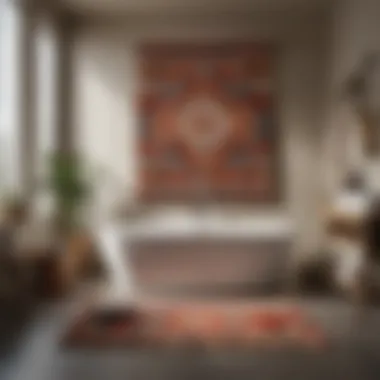
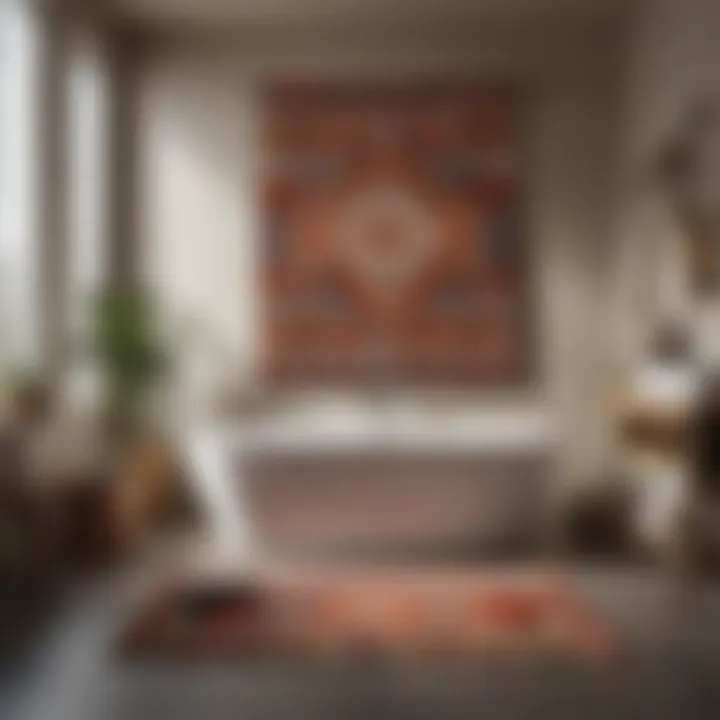
Understanding the dimensions of your bathroom is the first step when picking out a Navajo bath mat. A mat that's too large can overwhelm a small space, while one that's too small may not fulfill its intended purpose. Here are some key points to keep in mind:
- Measure Your Space: Before diving in, grab a tape measure. Take careful measurements of the area where you plan to place the bath mat.
- Consider Placement: Think about where the mat will go. Is it placed in front of the sink or in the shower area? Each location might require different dimensions.
- Visualizing Proportions: A good rule of thumb is to select a mat that allows for some flooring to show around its edges, creating a natural frame.
Thinking through these elements can transform your bathroom from merely adequate to truly inviting. A well-sized mat can create harmony within the space, while mismatched dimensions can make it feel off-balance.
Evaluating Quality and Authenticity
The craftsmanship of a Navajo bath mat significantly impacts its quality and authenticity. Many mass-produced items can be deceptive, so discerning buyers must keep a keen eye. To evaluate quality, consider:
- Material Composition: Authentic Navajo mats are typically made from natural fibers like wool, which are not only durable but also environmentally friendly. Check if the mat lists its materials.
- Craftsmanship Inspection: Look closely at the weave. Quality mats will display tight, well-executed knots and a consistent pattern. Any fraying or unevenness is a red flag.
- Source of Purchase: Consider where you buy from. Purchasing directly from reputable Native American artisans or trusted retailers who specialize in authentic Navajo textiles ensures your item is genuine.
"A beautiful mat is not merely an accessory. It's a conversation starter, a piece of history, connecting the homeowner to centuries of tradition."
By focusing on these factors, you're not only gaining a practical addition to your home but also engaging in the preservation of a remarkable heritage.
Incorporating the right Navajo bath mat into your home decor offers opportunities for personal expression while fostering connections to the rich traditions embedded within each piece.
Maintenance and Care
In the realm of interior design, the maintenance and care of any textile piece is paramount, especially for those imbued with rich cultural significance, like the Navajo bath mat. These pieces are not merely functional; they serve as a testament to artistry, heritage, and tradition. To retain the beauty and integrity of a Navajo bath mat, it is essential to incorporate consistent care practices. Proper maintenance not only prolongs the life of the mat but also honors the craftsmanship invested in each weave.
A well-maintained mat can be a lasting element in your home that bridges conventional use and decorative occasion. Let’s dive into some effective practices for cleaning and preserving these elements, ensuring they continue to enhance your space.
Cleaning Techniques
Keeping your Navajo bath mat clean is fundamental to sustaining its appeal. While the exact cleaning method may vary based on the materials used, generally, gentle techniques are advisable. Here are some methods to consider:
- Vacuum Regularly: To prevent dirt build-up, use a vacuum cleaner on a low setting. This action removes dust without damaging the fibers.
- Spot Clean Spills: For sudden mishaps, spot cleaning is your best ally. Instead of soaking, dab the stained area with a mild detergent mixed with water. Always blot, don’t rub, as rubbing can distort the fibers.
- Hand Wash When Necessary: If a deeper clean is needed, submerge the mat in a basin filled with lukewarm water and a few drops of gentle soap. Agitate lightly and rinse thoroughly, then lay flat to dry away from direct sunlight.
The unique patterns and colors of a Navajo bath mat might require special care considerations. Therefore, always check for any specific recommendations provided by the artisan or manufacturer.
Preserving Longevity
Ensuring the longevity of your Navajo bath mat goes beyond routine cleaning. Developing a preservation strategy can help in maintaining its beauty through the years:
- Keep Away from Direct Sunlight: Exposure to sunlight can fade colors and weaken fibers. Place your mat in shaded areas or windowless bathrooms when possible.
- Rotate Regularly: To maintain even wear, rotate the mat periodically. This practice not only protects high-traffic areas but also allows for continual appreciation of the artwork on display.
- Store with Care: When not in use, store the mat rolled up, in a dry environment. Avoid folding it to prevent creases that might not flatten out again.
Remember: A Navajo bath mat is a blend of art and function; respecting it through proper care enhances its life while showcasing its intrinsic value in your home.
By embracing these maintenance practices, you ensure that your bath mat continues to tell its story of cultural significance and craftsmanship for many years to come.
Cultural Appropriation vs. Appreciation
Understanding the difference between cultural appropriation and appreciation is crucial when discussing the significance of Navajo bath mats. This topic invites reflection on how these beautiful textiles exist within a broader social context. Cultural appropriation often refers to the act of borrowing elements from a culture, typically marginalized, without permission or understanding, leading to distortion or oversimplification of that culture. On the other hand, appreciation involves valuing and respecting the cultural significance behind those elements.
When it comes to Navajo bath mats, it’s essential to tread thoughtfully. These mats are not merely decorative pieces; they embody a rich heritage and history. Using them in modern interiors demands an understanding of and respect for the traditions they represent.
"True appreciation sees the story behind the artwork, allowing it to breathe life into modern spaces rather than simply being a trend."
Homeowners and individuals looking to incorporate Navajo designs should consider the implications of their choices. The benefits of understanding this line include fostering respect for indigenous culture, promoting education about Navajo artistry, and ensuring that local artisans are acknowledged and supported. It’s important to integrate these beautiful items into one’s decor in a manner that honors their origins, avoiding the pitfalls of appropriation.
Understanding the Line
To genuinely appreciate Navajo bath mats, one must first understand the delicate boundary between appropriation and appreciation. Immersing oneself in the story of the Navajo people reveals insights into their spirituality, customs, and artistic expressions. Instead of viewing these textiles merely as objects, seeing them as vessels of expression is vital.

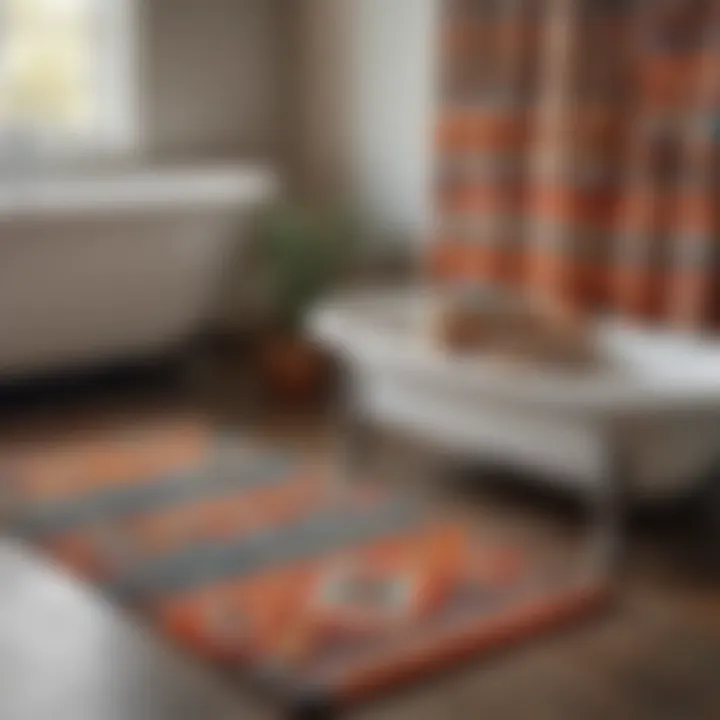
Here are a few considerations for those wanting to appreciate rather than appropriate:
- Learn the history: Understanding the traditional significance and personal stories behind the mats elevates them from mere decor.
- Connect with resources: Engage with literature, documentaries, or articles that delve into Navajo culture. Websites like Wikipedia offer valuable insights into the history and significance of Navajo textiles.
- Consider where you buy: Purchase directly from indigenous artisans or reputable sources. This ensures that the value remains within the community that creates these unique pieces.
Supporting Indigenous Artisans
To promote genuine appreciation, supporting indigenous artisans is essential. Buying a Navajo bath mat from a local weaver not only preserves traditional techniques but also uplifts the community. Each mat tells a tale woven into its fabric, appearing as a tapestry of cultural significance. Investing in these pieces is an investment in heritage.
Here’s how one can support these artisans while ensuring respect for their craft:
- Direct purchases: Whenever possible, buy directly from artisans at markets or their workshops. This not only supports their livelihood but also provides a chance to learn from the craftspeople themselves.
- Spread awareness: Share your knowledge about the significance of these mats. Encourage others to consider the stories behind their purchases and promote ethical buying behaviors.
- Participate in community events: Attend cultural events or exhibitions featuring Navajo art. This fosters connection and understanding between cultures, while directly backing the artisans' work.
By understanding the line between appropriation and appreciation, and taking active steps to support indigenous artisans, homeowners can bring personalized narratives to their spaces—truly enriching their environments with genuine meaning.
Incorporating Navajo Design in Modern Interiors
Integrating Navajo design into contemporary interiors is not just about throwing in a few colorful rugs; it's about embracing a rich tradition and narrating a story through decor. This delicate interplay between culture and modern aesthetics can create a warm, inviting atmosphere in homes while paying homage to Indigenous artistry. The unique patterns and colors found in Navajo textiles bring a certain depth that can transform a regular space into something extraordinary.
Balancing Tradition with Contemporary Styles
To achieve a harmonious blend of Navajo design and modern aesthetics, one must consider both form and function. Traditional Navajo designs often feature natural motifs, geometrical patterns, and vibrant colors, which can sometimes conflict with sleek modern styles. However, incorporating these elements thoughtfully can create a visually striking contrast.
For example, an elegant, minimalist bathroom can feel alive when accented with a bold Navajo bath mat. It's not about filling every nook and cranny with traditions from the past; instead, it’s about making strategic choices. Here’s how to strike that balance:
- Choose a Focal Point: Select one or two key pieces, such as a bath mat or wall hanging, to showcase the intricate woven designs of Navajo craftsmanship.
- Limit Color Palettes: Opt for mats that align with the existing color scheme of the room. This can help in keeping the space feeling cohesive.
- Mix Materials: Complement the textile with modern materials like glass or metal fixtures. This creates a contrast that is both sophisticated and grounded in cultural significance.
- Positioning Matters: Think about placement. A beautifully designed mat can soften hard edges and offer warmth when placed near functional areas.
Balancing these styles allows for a graceful coexistence between the old and the new, ultimately enriching the narrative of home décor.
Creating Personal Narratives through Decor
Navajo bath mats can serve as conversation starters while adding significant depth and meaning to interior design. Each piece carries stories, histories, and the spirit of the artisans who created them. Consequently, when homeowners incorporate these mats into their spaces, they are not just filling a gap; they are weaving personal narratives through their choice of decor.
To create that personal connection:
- Choose Intentionally: Pick mats that resonate with your story or values. It could be an inherited piece that has sentimental value or one that reflects your appreciation for Indigenous art.
- Layering Stories: Consider layering different textiles for a mix of stories. Combining Navajo mats with other cultural artifacts can draw connections between various narratives.
- Display with Purpose: When placing a Navajo mat, think about its placement and how it interacts with surrounding elements. Let it be viewed as an artwork rather than merely a functional item.
Bringing together diverse cultural influences while telling one’s own story can elevate the home from simply being a living space to a gallery of personal experiences and heritage. This creative endeavor fosters an appreciation for both the art of the past and the aesthetics of the present.
"To surround oneself with diverse narratives is to enrich one’s own story. Each piece has a tale waiting to be shared."
Incorporating Navajo designs thoughtfully into modern interiors not only honors tradition but also creates a unique living environment that reflects the homeowner's values and history.
The Future of Navajo Textiles
The landscape of Navajo textiles, including the ever-popular bath mats, is not just a reflection of rich heritage but also an indication of evolving design sensibilities. The future of Navajo textiles holds a promise, merging tradition with the demands of contemporary markets. This allows artisans to maintain their cultural authenticity while finding new ways to appeal to a broader audience. The adaptability of these artisans ensures that the beauty of traditional weaving techniques continues to be relevant, elevating both the craft and its creators.
Trends Influencing Contemporary Designs
As time marches on, trends in interior design continually shift, affecting how we perceive and integrate textiles into our lives. Here are some noteworthy trends shaping the future of Navajo bath mats:
- Sustainability: There's an increasing awareness around eco-friendly practices. Consumers are more interested in sustainable materials and processes. For Navajo artisans, this means emphasizing natural dyes, organic fibers, and sustainable sourcing of raw materials.
- Minimalism: Modern interiors often favor simplicity and clean lines. As such, Navajo bath mats are evolving to feature more minimalistic designs, allowing them to blend seamlessly into various decor styles while retaining their unique identity.
- Mix and Match: Contemporary homeowners are gravitating toward eclectic styles. Navajo textiles are being paired with other design elements, like metallic finishes or modern furniture, creating a visually striking contrast without losing respect for their origins.
"Navajo textiles are stylistic bridges, connecting the past with the present, while showcasing the creativity of the present-day artisan."
Innovation and Tradition
Balancing innovation with tradition is a dance that many Navajo artisans have learned well. While honorin' the rich history of their craft, many are experimenting with new techniques and materials that breathe fresh air into traditional methods. They are not stuck in a bygone era but are reinterpreting old motifs and methods to stay relevant in a fast-paced world.
- Technology Integration: Some artisans are utilizing digital tools for design and marketing. This not only enhances production speed but also provides them with avenues to showcase their work, potentially reaching a global audience.
- Fusion of Styles: Mixing traditional Navajo designs with influences from other cultures can create unique pieces that appeal to a wider public. This could lead to collaborations with modern designers who share an appreciation for the beauty of these textiles.
As we look toward the future, the amalgamation of tradition and modernity will likely give rise to a new generation of Navajo textiles, capturing the heart of their origins while meeting contemporary demands.
It’s a win-win situation for artisans and consumers alike, preserving culture while embracing progress.

